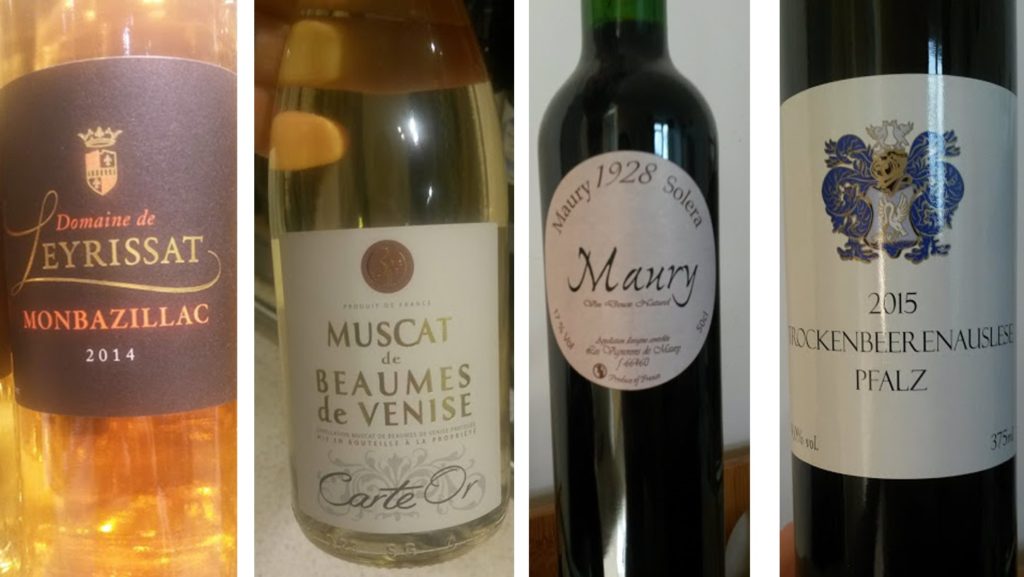 Otherwise known as ‘sweet wines’, ‘stickies’, or as my dad endearingly likes to call them “Nectar from the Gods”, dessert wines are sadly rarely drunk except at Christmas time (when we all frantically up our sugar intake) or as part of a food and wine pairing at posh restaurants, which is a real shame.
Otherwise known as ‘sweet wines’, ‘stickies’, or as my dad endearingly likes to call them “Nectar from the Gods”, dessert wines are sadly rarely drunk except at Christmas time (when we all frantically up our sugar intake) or as part of a food and wine pairing at posh restaurants, which is a real shame.
I’ve already looked at the fortified wines of Sherry, Port and Madeira which offer a range of lovely sweet wines options, but there are a whole multitude of other fortified sweet offerings to be found elsewhere, ranging from the Vin du Naturals of Southern France (Banyuls, Maury, Rivesaltes and the sweet Muscats of the Languedoc-Roussillon region) to the Rutherglen Muscats of Australia.
But for this week’s blog I am going to concentrate on unfortified sweet wines and the ways they are produced as well as giving a few tips for which wines pair best with certain deserts. One thing they all need to have in common is good levels of acidity to balance the sweetness, as without it they will just feel cloying and flabby – remember this if buying a cheap sweet wine.
How are they made?
The cheapest production methods, and the ones used for more everyday sweet wines involve arresting the fermentation by chilling the must then filtering out the yeast before all the sugar has been converted to alcohol therefore leaves the resultant wine with residual sugar (and lower alcohol).
Another way is to add sweetener – if you are imagining a winemaker adding buckets of Tate & Lyle to the wine then don’t worry, they don’t! Winemakers are allowed to add sweetness but it must be a grape related product – whether Sussreserve (unfermented grape juice) or Rectified Concentrated Grape Must.
Far and away though the best, most natural way to create great quality ‘stickies’ involves the concentration of naturally occurring sugars in the grapes – this can be achieved by several processes and it’s no coincidence that the better quality sweet wines will be both expensive and come in smaller 37.5 or 50cl bottles – this is because of the labour intensive methods used to create them coupled with the minute quantities of wine that are produced.
All of the below require the late harvesting of the grapes – which as the name suggests means leaving the grapes longer than usual before picking which means fully ripened with higher sugar levels.
Botrytis Cinerea (aka “Noble Rot”) – which sounds nicer than saying a fungus which dehydrates the grapes thus concentrating the sugars. How the fungus causes this dehydration is fascinating albeit somewhat geeky so I won’t go into any more detail (if you are interested mail me!). This naturally occurring fungus requires very precise climatic conditions to occur: namely misty mornings and warm sunny afternoons as too much dampness will just cause rot. Its hugely labour intensive, required numerous passes through the vineyard to handpick the grapes, only produces small amounts of wine, and can’t be relied on each year to even occur…all of which go some way to explaining why they are so expensive.
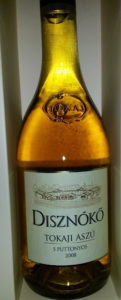 Botrytis is responsible for some of the best known (and loved) stickies in the world: including France’s Sauternes, Montbazillac and the Selection de Grains Nobles (SGN) wines from Alsace, Hungary’s Tokaji Aszu, Australia’s Botrytis Semillon, as well as some truly stunning German and Austrian stickies: Trockenbeerenauslese (TBA) or Beerenauslese (BA).
Botrytis is responsible for some of the best known (and loved) stickies in the world: including France’s Sauternes, Montbazillac and the Selection de Grains Nobles (SGN) wines from Alsace, Hungary’s Tokaji Aszu, Australia’s Botrytis Semillon, as well as some truly stunning German and Austrian stickies: Trockenbeerenauslese (TBA) or Beerenauslese (BA).
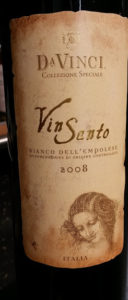 Drying and shrivelling of the grapes so concentrating the sugars/flavours (global terms include Passerillege and Appassimento, you may hear the term ‘Straw wine‘ – it’s the same thing). Grapes are harvested late in the season when they are very ripe (full of sugar), they are either dried on the vine or laid out and dried on straw mats to shrivel and raisin. This process is used to make wines such as: Recioto de Soave, Recioto della Valpolicella, Vin Santo, Passito di Pantelleria.
Drying and shrivelling of the grapes so concentrating the sugars/flavours (global terms include Passerillege and Appassimento, you may hear the term ‘Straw wine‘ – it’s the same thing). Grapes are harvested late in the season when they are very ripe (full of sugar), they are either dried on the vine or laid out and dried on straw mats to shrivel and raisin. This process is used to make wines such as: Recioto de Soave, Recioto della Valpolicella, Vin Santo, Passito di Pantelleria.
NOTE: Amarone production also involves this technique but in this case the wine is fermented to near dryness and is consequently also pretty high in alcohol (and is NOT a dessert wine)
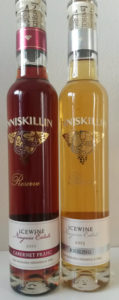 Ice Wine (aka Eiswein) – Healthy grapes (ie those unaffected by Noble Rot or any other form of rot for that matter!) are left to freeze on the vine into the winter months, this process requires specific climatic conditions….temperatures of minus 8OC to be precise and unsurprisingly these conditions only occur in a few places globally: the best examples coming from Canada and Germany. The sugars in the must are concentrated because the water (as ice) is extracted during pressing leaving musts with really high sugar levels. These are amongst my favourite sweet wines there is a real clarity and precision of flavours and the sugars are perfectly balanced by the acidity. Some grapes work brilliantly as ice wines namely: Riesling, Cabernet Franc and Vidal (a Canadian hybrid which is dull when making dry wine but comes into its own when used for ice wine production).
Ice Wine (aka Eiswein) – Healthy grapes (ie those unaffected by Noble Rot or any other form of rot for that matter!) are left to freeze on the vine into the winter months, this process requires specific climatic conditions….temperatures of minus 8OC to be precise and unsurprisingly these conditions only occur in a few places globally: the best examples coming from Canada and Germany. The sugars in the must are concentrated because the water (as ice) is extracted during pressing leaving musts with really high sugar levels. These are amongst my favourite sweet wines there is a real clarity and precision of flavours and the sugars are perfectly balanced by the acidity. Some grapes work brilliantly as ice wines namely: Riesling, Cabernet Franc and Vidal (a Canadian hybrid which is dull when making dry wine but comes into its own when used for ice wine production).
So what do they taste like?
Well…it depends! There are a lot of factors at play here namely the grape varieties used, the production methods employed and how (and if) the wine is aged. I touched on oxidative ageing in previous posts on Port, Sherry and Madeira and the same applies for some of the VDNs such as some Rivesaltes (look for the term ambre/tuile) and Rutherglen Muscat (which is darker in colour – made from Brown Muscat) and has more nuts and treacle and caramel notes.
For VDN wines such as Beaumes du Venice made from the white Muscat grape (Muscat Blanc Petit Grains) the wines are highly perfumed, floral, grapey and honeyed.
As a rule of thumb the types of flavours you will get from wines affected by Noble Rot ie Sauternes, Tokaji Aszu will be more along the citrus and stone fruit spectrum ie orange, peach, apricot marmalade alongside honey and vanilla. Tokaji tending more towards barley sugar and tea notes.
Wines that use red grapes ie some Recioto della Valpolicella will have chocolatey, more raisined characteristics, the French VDNs such as Maury and Rasteau will be similar stylistically to Port ie black fruits, chocolate, spice.
Finally we have the luscious Icewine – usually Riesling or Vidal. High sweetness levels with flavour characteristics more along the tropical fruit spectrum (pineapple, lychee), floral with honeyed notes. These wines are usually lower alcohol with a bracing acidity. Note: when Cabernet Franc is used there will have more red fruit flavours ie strawberry, raspberry.
Food and Wine Matching
When deciding what to drink with my festive pudding I look for a wine that will not overpower the food, one that will match or complement the flavour profiles. Here are a few tips:
Christmas Pudding/ Mince Pies: I’d be looking for something to complement the raisins/nuts/spice so would look for a Malmsey Madeira, Tawny port or PX Sherry.
Sherry Trifle: kind of speaks for itself….a sherry (remember though to use one of the sweeter ones ie PX or Oloroso as a dry Fino would likely destroy your palate and your meal!)
Fruit based deserts ie Lemon Tart: a floral Muscat (ie Beaumes du Venice) with its lifted citrus notes will work nicely as would ice wines (Vidal or Riesling), the Late harvest German rieslings and Tokaji or Sauternes.
Chocolate cake/Pudding: darker skinned Muscats are great (ie Rutherglen Muscat or Black Muscat – Elysium do a good one that I recently paired for a tasting menu). Malmsey works well here as well.
Cheese: obviously Port is always a winner, but if you are looking at a blue cheese then Sauterne and Tokaji are brilliant matches, the lovely sweet/salty combination works fantastically.
On that note, all that is left for me to say is to wish you a very happy Christmas – eat, drink and be very merry….
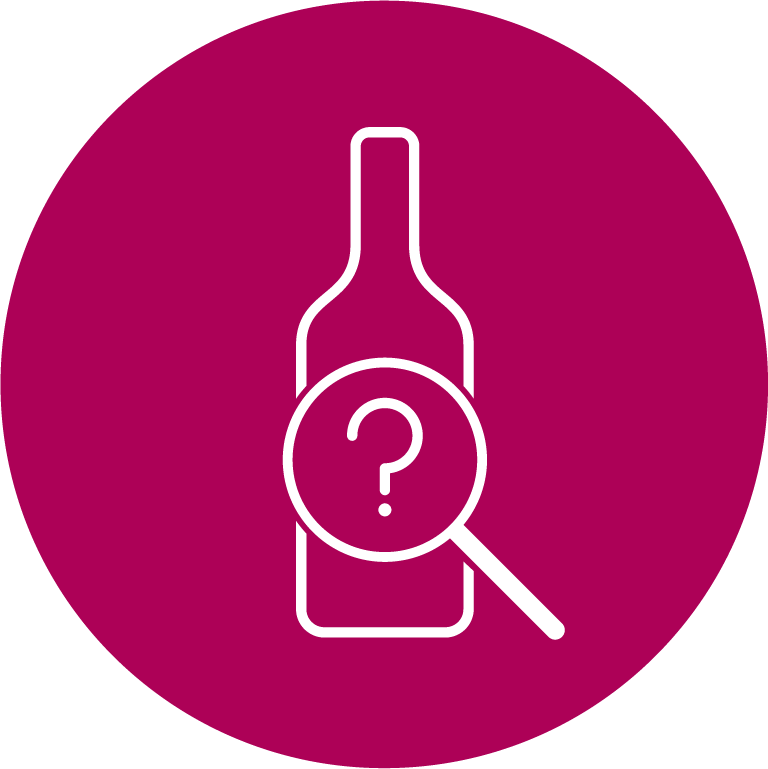
Ooh I remember I bought home a botrytus when I visited the Barossa about 20 Year’s ago and it was bloody lovely. But my fave is undoubtedly the Tokaji Aszu. Although I have been known to murder the odd tiramisu here and there……!
Another entertaining and informative post.
Hoping to enjoy a drop or several of a vine dried Sauvignon blanc from Asara estate inStellenbosch, which a friend brought back from South Africa.
Thanks Sue. Not tried the vine dried style but have drunk a few kiwi late harvest savvies and they were lovely – the grape works brilliantly in this style. Let me know what it is like.
You can often get better value stickies by looking away from big name more globally recognised wines (Sauterne!) The tricky thing is being able to source them. Ice wines are well worth a try but are expensive! Botrytis Riesling or late harvest wines from new world countries like NZ are often good value for money too.